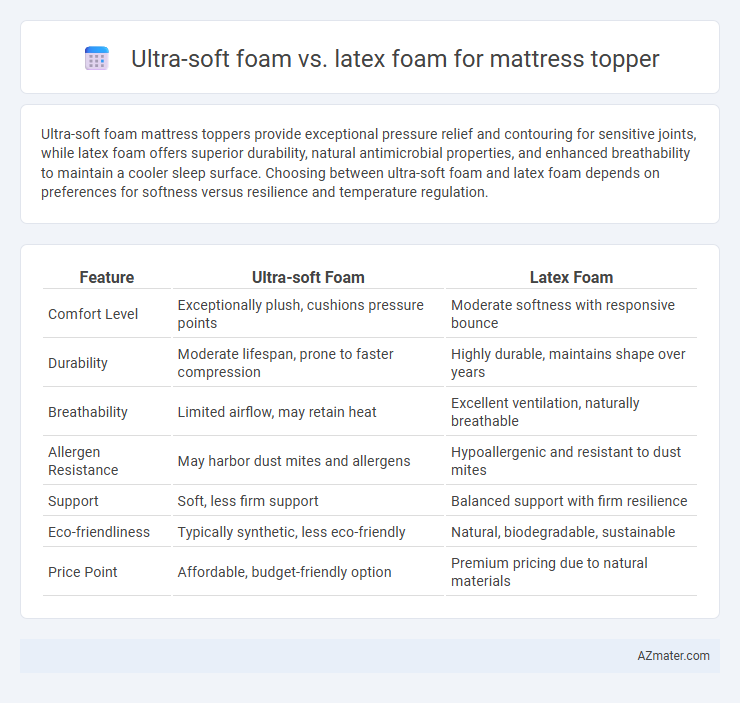Ultra-soft foam mattress toppers provide exceptional pressure relief and contouring for sensitive joints, while latex foam offers superior durability, natural antimicrobial properties, and enhanced breathability to maintain a cooler sleep surface. Choosing between ultra-soft foam and latex foam depends on preferences for softness versus resilience and temperature regulation.
Table of Comparison
| Feature | Ultra-soft Foam | Latex Foam |
|---|---|---|
| Comfort Level | Exceptionally plush, cushions pressure points | Moderate softness with responsive bounce |
| Durability | Moderate lifespan, prone to faster compression | Highly durable, maintains shape over years |
| Breathability | Limited airflow, may retain heat | Excellent ventilation, naturally breathable |
| Allergen Resistance | May harbor dust mites and allergens | Hypoallergenic and resistant to dust mites |
| Support | Soft, less firm support | Balanced support with firm resilience |
| Eco-friendliness | Typically synthetic, less eco-friendly | Natural, biodegradable, sustainable |
| Price Point | Affordable, budget-friendly option | Premium pricing due to natural materials |
Understanding Ultra-Soft Foam and Latex Foam
Ultra-soft foam mattress toppers provide exceptional cushioning and pressure relief with their lightweight, highly pliable structure, ideal for enhancing comfort on firm beds. Latex foam, derived from natural or synthetic sources, offers superior resilience, breathability, and antimicrobial properties, ensuring sustained support and temperature regulation. Understanding the key differences in material composition and performance helps consumers select a mattress topper tailored to personal comfort preferences and sleep needs.
Key Differences Between Ultra-Soft Foam and Latex Foam
Ultra-soft foam mattress toppers offer exceptional contouring and pressure relief due to their viscoelastic properties, enhancing comfort for side sleepers and those with joint pain. Latex foam mattress toppers provide durable support with natural elasticity, promoting better spinal alignment and breathability, ideal for users seeking resilience and hypoallergenic benefits. Key differences include the ultra-soft foam's slower response to pressure versus latex's faster bounce-back, alongside latex's superior moisture-wicking and antimicrobial attributes compared to synthetic ultra-soft foams.
Comfort and Support Comparison
Ultra-soft foam mattress toppers provide exceptional comfort by contouring closely to the body's curves, relieving pressure points with their plush feel. Latex foam offers superior support with its resilient and responsive properties, promoting spinal alignment while maintaining a cooler sleeping surface. Choosing between ultra-soft foam and latex foam depends on whether prioritizing cushioning comfort or durable support for consistent sleep quality.
Pressure Relief Capabilities
Ultra-soft foam mattress toppers offer excellent pressure relief by contouring closely to the body's curves, reducing stress on sensitive areas such as hips and shoulders. Latex foam toppers provide responsive support with natural elasticity, promoting better spinal alignment while still alleviating pressure points. Both materials enhance comfort, but ultra-soft foam excels in immersive cushioning, whereas latex foam balances pressure relief with resilience and breathability.
Durability and Longevity
Latex foam mattress toppers offer superior durability, often lasting up to 10 years due to their natural resilience and resistance to sagging. Ultra-soft foam toppers, while providing immediate plush comfort, tend to compress and lose support within 2 to 3 years, reducing their long-term effectiveness. Choosing latex foam enhances mattress longevity by maintaining shape and support, making it a more durable investment.
Hypoallergenic Properties and Health Factors
Ultra-soft foam mattress toppers often contain synthetic materials that may emit volatile organic compounds (VOCs), potentially affecting indoor air quality and respiratory health. Latex foam, especially natural latex derived from rubber trees, is inherently hypoallergenic, resistant to dust mites, mold, and bacteria, making it a superior choice for allergy sufferers. Choosing natural latex foam can improve sleep hygiene and reduce the risk of allergic reactions compared to conventional ultra-soft synthetic foams.
Motion Isolation and Noise Reduction
Latex foam mattresses excel in motion isolation due to their dense, responsive structure that absorbs movement effectively, minimizing disturbance between sleepers. Ultra-soft foam offers superior noise reduction, as its pliable material dampens sounds generated by pressure and movement, ensuring a quieter sleep environment. Both materials provide excellent motion isolation, but latex foam tends to deliver a firmer bounce while ultra-soft foam emphasizes quiet, contouring comfort.
Temperature Regulation and Breathability
Ultra-soft foam mattress toppers typically offer moderate breathability due to their open-cell structure, which promotes airflow and helps dissipate heat effectively. Latex foam excels in temperature regulation because of its naturally porous composition, providing superior breathability and moisture-wicking properties that prevent heat retention during sleep. Choosing latex foam ensures enhanced airflow and cooler sleep environments, while ultra-soft foam provides comfort with reasonable temperature control.
Eco-friendliness and Material Sourcing
Ultra-soft foam mattress toppers typically use polyurethane-based materials, which rely on petrochemical resources and often involve less sustainable manufacturing processes, impacting their eco-friendliness negatively. Latex foam, especially natural latex sourced from rubber tree sap, offers a renewable and biodegradable option with minimal chemical additives, promoting sustainable material sourcing and reduced environmental impact. Certifications such as GOLS (Global Organic Latex Standard) and OEKO-TEX can further verify eco-conscious production in latex foam mattress toppers.
Choosing the Best Foam for Your Sleeping Style
Ultra-soft foam mattress toppers provide exceptional pressure relief, ideal for side sleepers seeking cushioning for shoulders and hips, while latex foam offers responsive support and durability, perfect for back and stomach sleepers who need spinal alignment. Latex foam's natural breathability and hypoallergenic properties benefit allergy sufferers, whereas ultra-soft memory foam molds closely to the body, enhancing comfort but may retain heat. Selecting the best foam depends on your sleeping position, temperature preferences, and any sensitivity issues to ensure optimal rest and support.

Infographic: Ultra-soft foam vs Latex foam for Mattress topper
 azmater.com
azmater.com